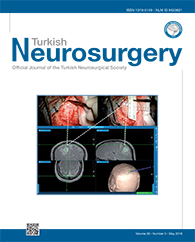2Ninth People?s Hospital, Shanghai Jiaotong University, Department of Orthopedics, Shanghai, China DOI : 10.5137/1019-5149.JTN.19980-17.1 AIM: To describe a modified Jaslow-transforaminal lumbar interbody fusion (TLIF) technique for the treatment of single-level, isthmic spondylolisthesis (IS).
MATERIAL and METHODS: Between April 2011 and September 2012, 32 patients with IS undergoing a modified Jaslow-TLIF were retrospectively reviewed. The intervertebral space height (IH), vertebral slippage ratio, lordotic angles of the treated segments (SA) and lumbar lordotic angles (LA) were measured and the scores by Visual Analogue Scale (VAS), Oswestry Disability Index (ODI) and Japanese Orthopaedic Association (JOA) were recorded.
RESULTS: An average follow-up duration of over 2 years was available. The average slippage percentage was 17.8±4.3% preoperatively, 5.3±2.4% postoperatively, and 5.4±2.5% at the last follow-up. The average IH was 7.7±1.9 mm preoperatively, 10.3±1.6 mm postoperatively, and 10.2±1.5 mm at the final follow-up. The average SA and LA were, respectively, 11.7±5.8° and 49.1±13.9° preoperatively, 13.5±5.7° and 48.3±9.4° postoperatively, and 13.2±5.3° and 47.7±8.8° at the last follow-up. The mean VAS was ameliorated from 7.7±0.6 to 2.4±0.5, ODI from 49.6±1.6% to 10.5±1.3%, and JOA from 10.8±1.3 to 26.6±1.0, at the last follow-up. All patients had clinical and radiographic evidence of solid fusion without any need for revision.
CONCLUSION: The modified Jaslow-TLIF technique for the treatment of IS was advantageous for greater safety and efficacy.
Keywords : Insert-and-rotate technique, Isthmic spondylolisthesis, Modified Jaslow technique, Transforaminal lumbar interbody fusion




